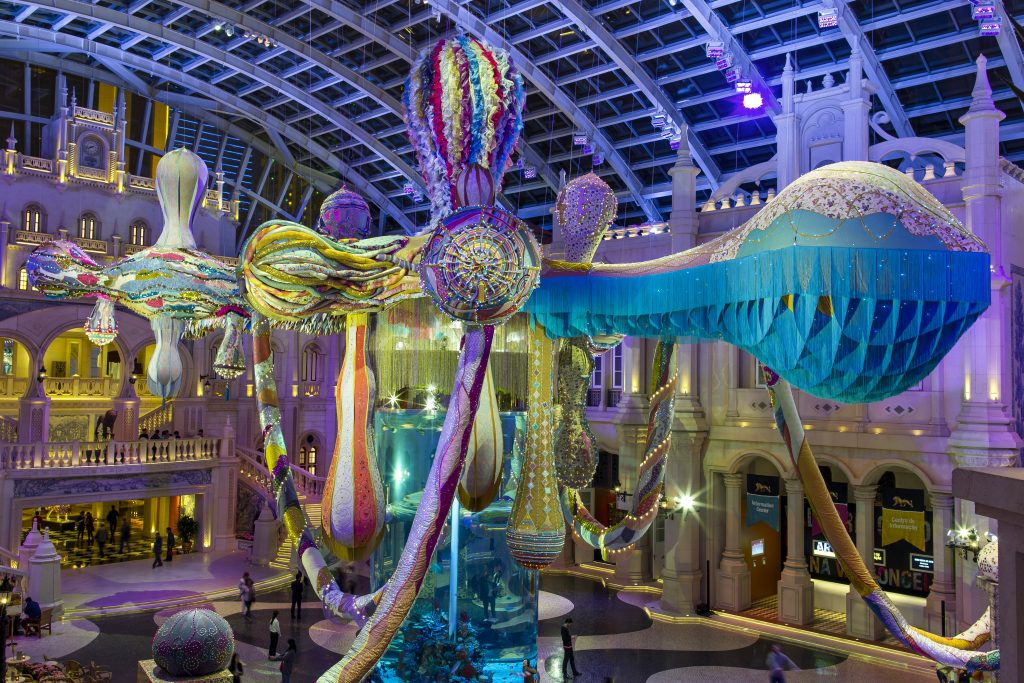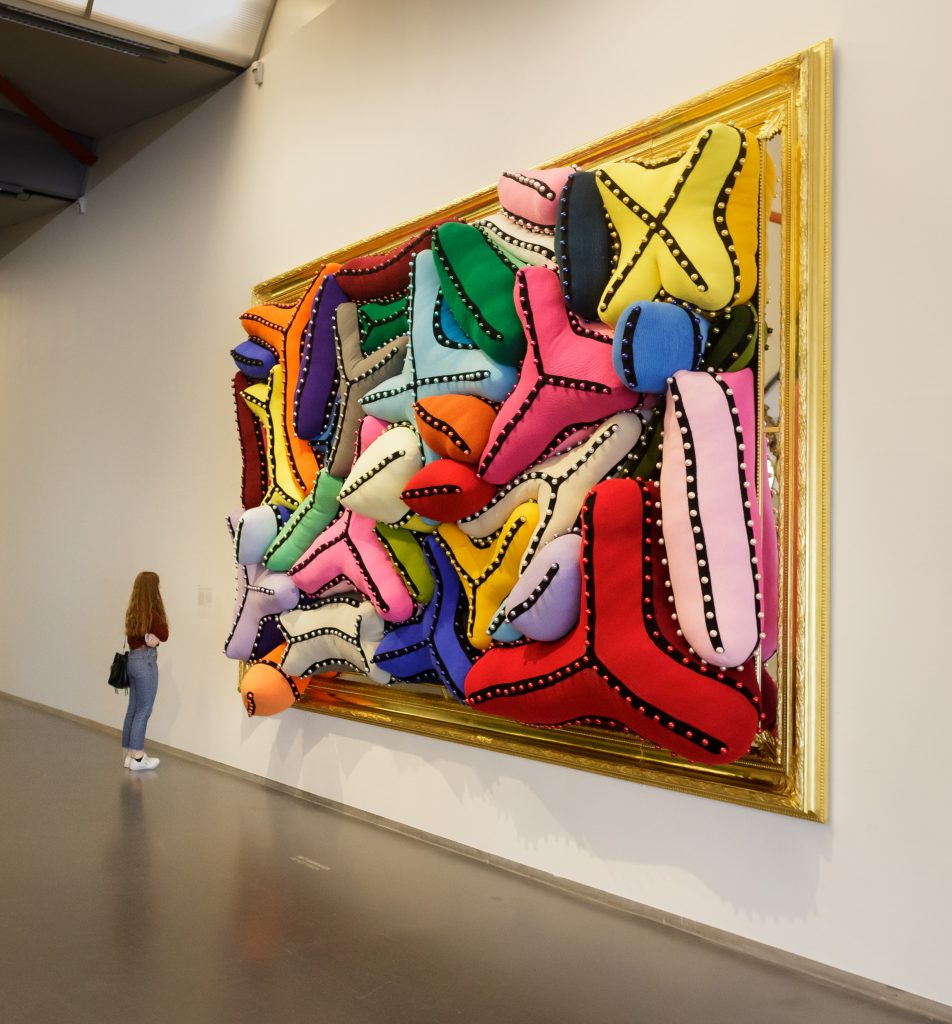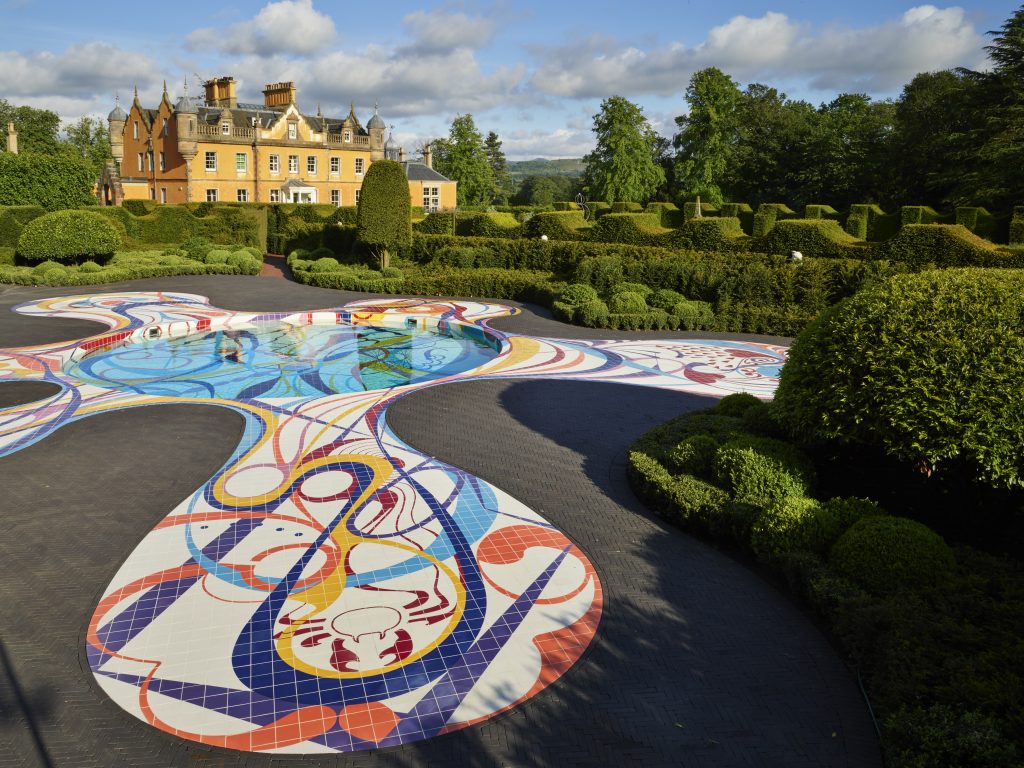#culture / #art & design
Joana Vasconcelos creates vibrant world with giant installations through traditional crafts
BY #legend
February 2, 2023
Lisbon-based Portuguese artist Joana Vasconcelos tells Dionne Bel how she hopes to make the world a better place through her monumental, vibrant works that show off an abundance of traditional crafts

In Joana Vasconcelos’s world, nothing is as it seems. Her playful, colourful works may at first resemble ever yday objects easily recognisable by different cultures, but take a closer look and you’ll see unlikely assemblages of readymade materials that make you ponder at their construction: a pair of high heels crafted from kitchen pots, a Venetian mask made from Baroque mirrors, a solitaire diamond ring made of car wheel rims and topped with whisky glasses, a feathered helicopter, a pistol constructed of old-fashioned telephones or a heart formed from red plastic cutlery.

“It’s like that in life,” she explains. “You can always have a different perspective on people and objects. You think that you are somebody and, in the end, you’re somebody else. A casserole can also be a shoe. It depends on your creativity and how you relate to things, but things don’t need to look exactly as they are and can always be something else.”
Once you get past her sculptures’ gargantuan scale and seductive theatrics, you’ll find social statements of gender, sexuality, femininity, cultural identity, consumer society and the sustainability of the planet surfacing, as she’s driven by concept rather than material or technique.
Nonetheless, Vasconcelos’s creations are often a carefully considered celebration of Portuguese crafts. Acting like a cultural ambassador intent on preserving her nation’s savoir-faire that’s an integral part of its identity, she has always featured craft heavily in her oeuvre. Dialoguing closely with the architecture they inhabit, her multicoloured, tentacular Valkyries series is named after famous women from history and based on the beautiful maidens of Norse mythology, who fly over battlefields to guide the souls of slain warriors.

Often suspended from the ceiling, these mobile structures resembling otherworldly creatures are made entirely of hand-knit, embroidered, sequin-strewn or crocheted sections. Using local brands wherever her Valkyries are exhibited, such as Liberty in England or Kvadrat in Denmark, she notes, “If you think about China, you think about silk. If you think about Africa, you think about capulanas. So it’s true that you always have a fabric associated with a cultural identity. I like to create a link with the local history and heritage of a place, and working with fabrics is one way of creating that connection.”
A decade since Vasconcelos became the first female and youngest artist to exhibit at the Palace of Versailles in France, in a show that registered a record-breaking 1.6 million visitors, she is getting ready to unveil a ceramic temple to love in the shape of a three-tiered wedding cake at Waddesdon Manor in Buckinghamshire, England. Her most ambitious project to date, the Wedding Cake pavilion will host marriages, with the bride and bridegroom ascending to the summit to become the two figurines that usually top a wedding cake. Additionally, she’s preparing a Valkyrie for Dior’s womenswear fashion show in Paris to be held in February and her first solo exhibition in China at Tang Contemporary Art gallery in Beijing in April.

You were born in Paris after your parents escaped from the Salazar dictatorship in Portugal…
My Maoist, left-wing parents were political refugees in Paris because of the colonial war in Portugal. They were part of the May ’68 movement, and I was born in 1971 in a spirit of liberté, égalité, fraternité [French motto meaning “liberty, equality, fraternity”]. When we went back to Portugal after the revolution, they continued to follow their political ideals, but then they became part of the reconstruction of a country that had been shut down under a dictatorship for 47 years. I was not brought up in a conservative Catholic family; I was brought up in a very revolutionary and intellectual family that was keen to make a difference for their country. My father was good friends with many artists, my uncle with a lot of politicians and my auntie with a lot of intellectuals. They helped to build a new identity for Portugal, a more contemporary country, and I can see that all the debates and political and cultural discussions during my childhood helped to build who I am today.

What was it like being born into a very artistic family?
My father studied architecture, then became a war photographer, my mother studied furniture restoration, my grandmother was a painter, and my auntie is a poet and a writer. They allowed me to pursue my dreams with great freedom, so when I started studying art, learning jewellery, drawing and design, nobody tried to dissuade me. Unlike many parents who don’t want their children to study art, my family really supported me.
Also see: Louis Vuitton x Yayoi Kusama: The art of infinity
Why are many of your sculptures monumental in size?
Scale is part of the process, but not the most substantial one. My work starts very conceptual and when I’m thinking about the relationship of the piece with the building or with the different materials that I’m going to use, I discover the scale. At the beginning, I’m always thinking about how this object will communicate what I’m trying to say, will it be conceptually understandable or relevant and am I choosing the right materials to express myself? When all that is answered and I decide to make it, I make technical drawings and only then can I find the scale.

What inspires you?
Everything that surrounds me is a source of inspiration. The result of my work is the combination of my experiences, my personal life and my family heritage. A flower, a movie, a concert, the people you meet and the conversations you have will always add something to who you are, and you cannot build an artwork without having something to say.

What do you like about showcasing and updating traditional crafts in your artworks?
I really like to learn about local crafts from everywhere, but mainly from my country, because they transport a lot of information and a more intimate perspective in the sense that it’s really important to connect with tradition. You cannot leave the present to create the future without having knowledge of the past. It doesn’t mean that the past needs to come with you. It means that you need to acknowledge the past and say this is really important, it makes sense for me to continue this or not. A lot of the things that you do today are a result of the past, but if you can release yourself from the bad things of the past and keep the good ones, I think that’s worthwhile. All the techniques that I use come from a very traditional Portugal, and some of them are useful for me to develop my work, while some aren’t, so it’s a question of adapting them to what I do, but they also need to make sense for me to use them.

Describe your upcoming installation Tree of Life at Sainte-Chapelle de Vincennes, a Gothic royal chapel on the eastern edge of Paris.
It is very philosophical in a sense. It was inspired by Gian Lorenzo Bernini’s marble sculpture Apollo and Daphne in Galleria Borghese in Rome. In Greek mythology, Apollo is in love with Daphne and wants to marry her, but she’d rather be transformed into a tree than marry him. It’s one of the most beautiful sculptures in the world. During lockdown, I had sent my team home to hand-embroider 110,000 leaves for Tree of Life. Meanwhile, I was invited to exhibit in Sainte-Chapelle. I wanted to do something that was extraordinary after Covid-19. I went there with Jean-François Chougnet, the director, and we said why don’t we do the tree, as I had already been working on it? The incredible stained-glass windows at the back of the chapel depict Armageddon and represent the end of the world, while Tree of Life represents the beginning – it’s a symbol of renovation, hope and life.

Tell me about the mission of the foundation you established in 2012 and the art scholarships you award.
One of the big issues here in Portugal is that many students give up their art studies at the beginning of their university course because they’re not able to pay for tuition, so I decided that I would help more people to become artists by giving scholarships to the best students. People were asking me to help and I said I can design a logo, a trophy or something that is not my main business, and all the money that I raise, I’ll put it in the foundation and give it away in scholarships. We have helped a community of around 20 students so far, and we already have the results of that investment: some are employed, some are teachers and some are artists. I’ve visited all over the world and I understood that you could make a difference, even on a small scale. Every year, I try to do better and to give more. #
Photos courtesy of Joana Vasconcelos
Also see: Louis Vuitton x Yayoi Kusama: The art of infinity























































